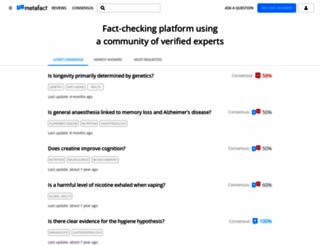Fact-checking platform powered by science - Metafact
Page Load Speed
1.5 sec in total
First Response
369 ms
Resources Loaded
1.1 sec
Page Rendered
57 ms

About Website
Click here to check amazing Metafact content. Otherwise, check out these important facts you probably never knew about metafact.io
Metafact is a place to verify knowledge via the world’s top experts. It’s a platform to ask questions, learn the facts and share the truth.
Visit metafact.ioKey Findings
We analyzed Metafact.io page load time and found that the first response time was 369 ms and then it took 1.2 sec to load all DOM resources and completely render a web page. This is quite a good result, as only 25% of websites can load faster.